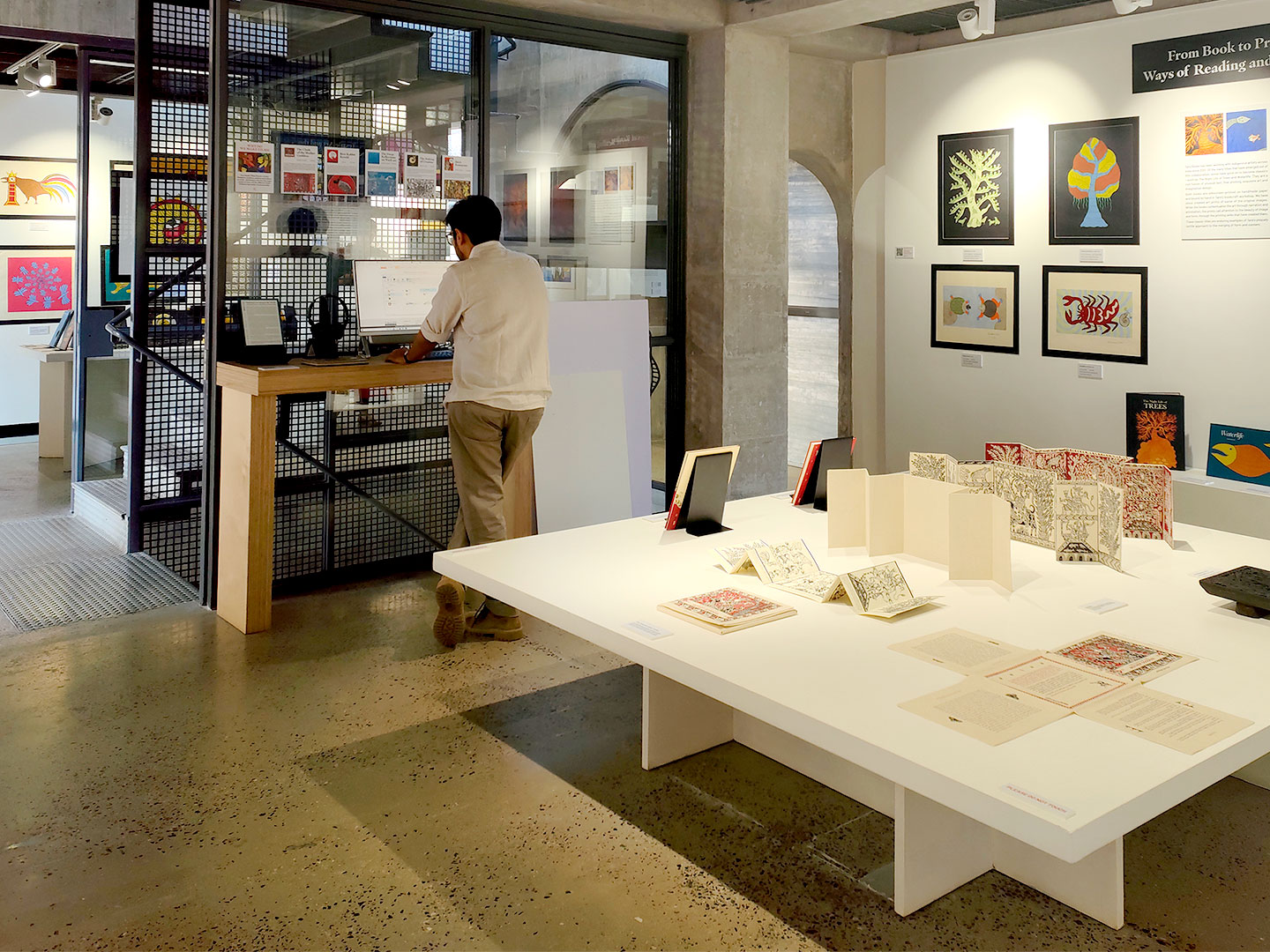
13 Mar Why Curate When You Can Publish?
by V. Geetha
On February 19, 2022, an exhibition curated by Tara Books opened at Arthshila, Ahmedabad, in western India. Titled Painting Everything in the World: The Book and the Arts, it featured our work with diverse Indian indigenous artists and art traditions.
For two years, starting from 2020, when the coronavirus pandemic had thrown much of the world out of gear, if not into despair, indigenous artists in India, with whom we have worked for two decades and more, found themselves without work. Many amongst them draw for a livelihood and rely on exhibitions and fairs to present and sell their art. But now that was not possible. Yet they continued to paint and create, as they waited for better times. Painting Everything in the World was conceived of as a thanksgiving to this creative spirit which has sustained artists and artist communities in difficult years.
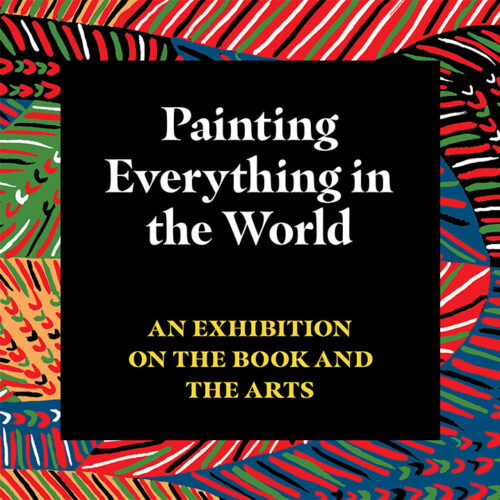
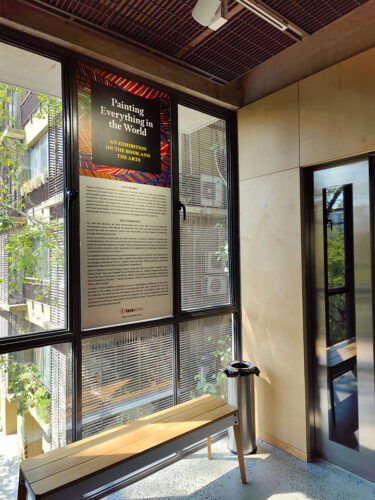
For over twenty years now, we have curated exhibitions to do with our books and publishing. Some of these have focused on individual titles, others on our book-making, and yet others on broad themes that define our intertwined publishing concerns — to do with content, form and printing. As we worked on Painting Everything in the World, we pondered over these other exhibitions. What, we asked ourselves, is the relationship between curation and publishing?
Painting Everything in the World:
An Exhibition on the Book and the Arts at Arthshila, Ahmedabad
Connections and Conversations
In a fundamental sense, we curate because we are visual publishers. In addition to the original art that artists create for our books, we have gathered art and craft objects over the years, building as it were, a visual archive. Not all of this comes into the book, and we therefore seek to display what we have collected under the broad themes that have interested us as publishers.

Curating choices: Mock-up of a panel from the exhibition, Made by Hand
Also, for us, publishing is about connections and conversations, between different creative acts and contexts. Each of our books has been the result of a process of intense dialogue, between artists, authors, editors, designers and printers. An exhibition enables us to visualise this process for our readers, and to all others interested in the arts and crafts.
What does it mean to publish — and curate — from a sense of ‘connectedness’? Connections are actualised in both books and exhibitions in any number of ways. In Between Memory and Museum: A Dialogue with Folk and Tribal Artists, the book embodies dialogue, with the page becoming the site for conversations between artists, writers and editors.
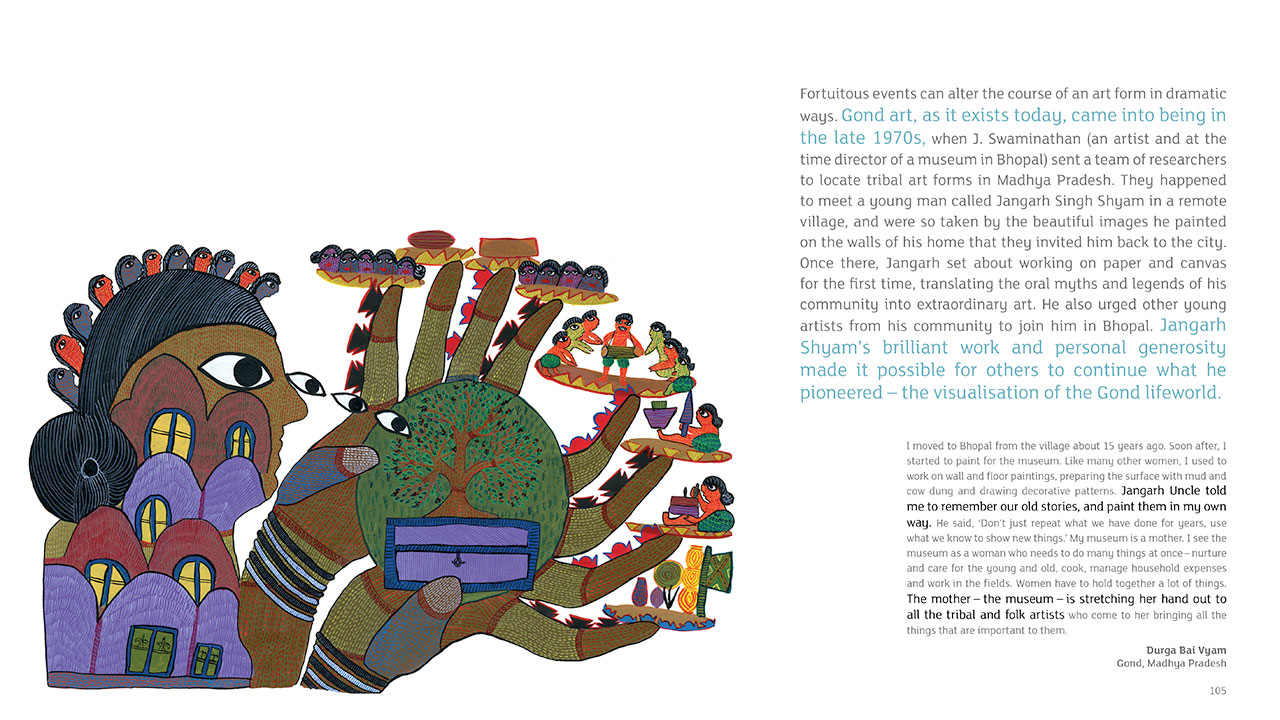
Where history, memory and art echo each other:
A page from Between Memory and Museum
In some instances, the designer enters into conversation with the author and artist: in Origins of Art: the Gond Village of Patangarh, the designer introduced an additional element, in the form of illustrations which worked as visual ‘quotations’, and augmented the content of the text and photographs.
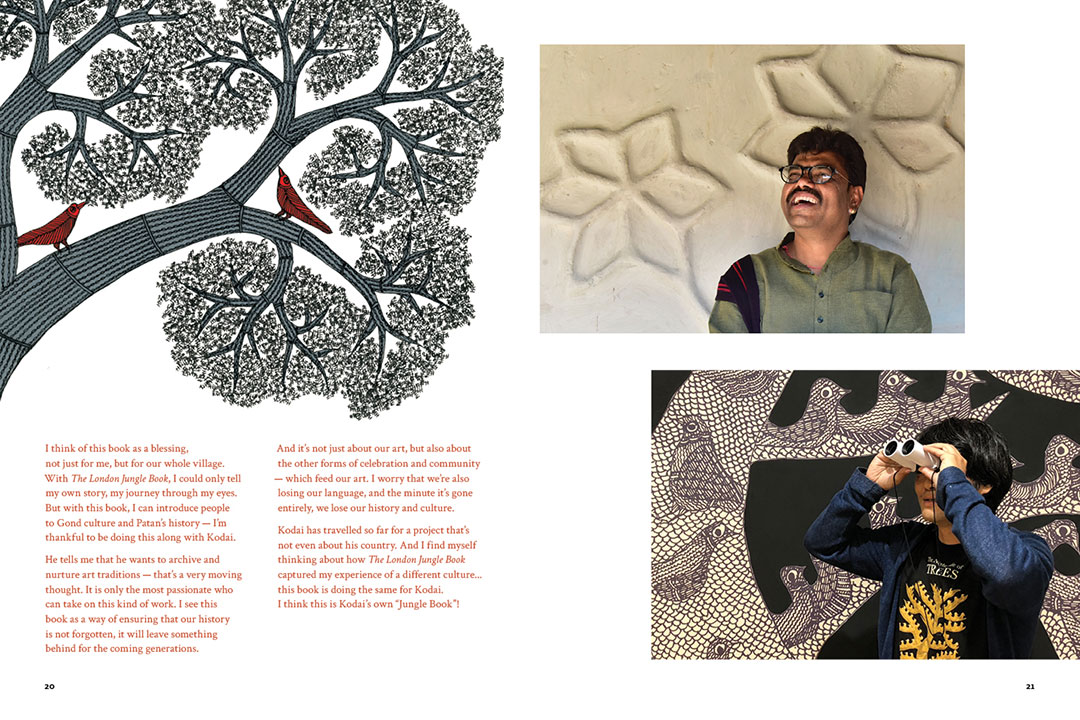
Illustration: The third element in the narrative
In Little Girls are Wiser than Men, the printing process interacts with the distinctive nature of the art — the book was letterpress-printed to do justice to the fine etchings created by the artist Hassan Zahreddine.
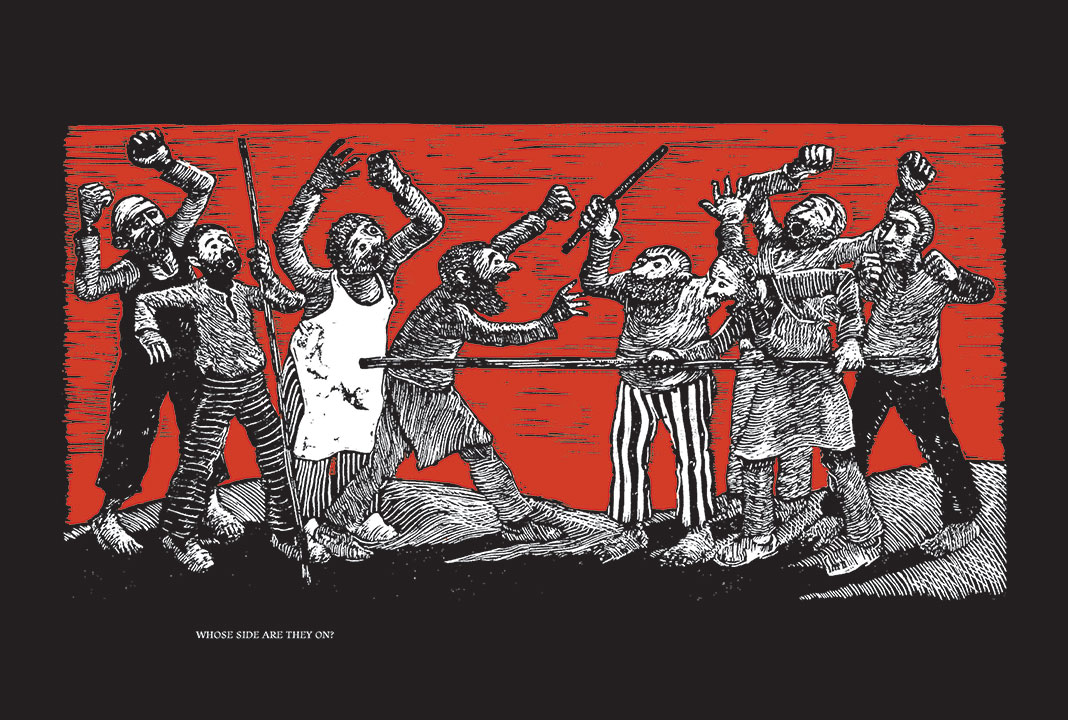
Wiser than them: Page from Little Girls are Wiser than Men
Partnerships with authors and cultural forums from across the world have made for unique exchanges: Another History of the Children’s Picturebook: from Soviet Lithuania to India, a book which features multiple levels of dialogue, between authors, cultures and histories.
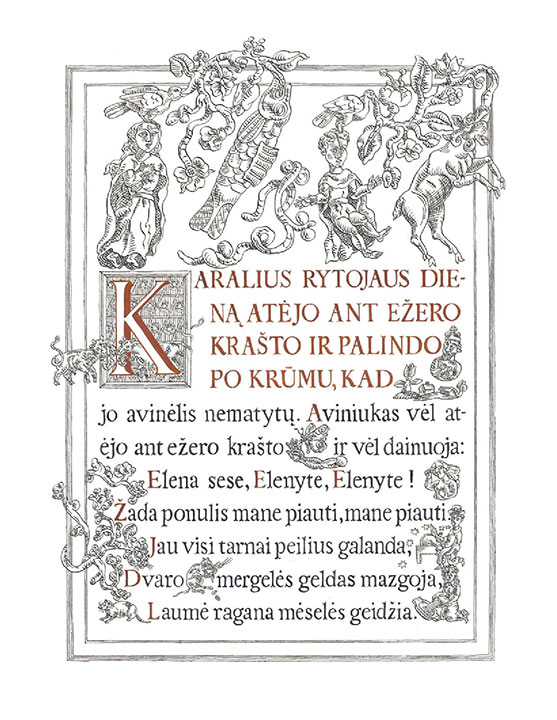
Letterpress-printed Lithuanian folk-tales
In order to engage potential readers in dialogue, we produce information sheets that go with our titles, which, among other things, feature interesting back stories behind the book in question.
As far as our exhibitions are concerned, they have echoed and amplified the spirit of dialogue that shapes our publishing. Curation, in this sense, has enabled us to communicate the meaning of what we do: we curate to explain our work, explore themes and ideas that have inspired it, to teach, and to communicate our sense of creative play.
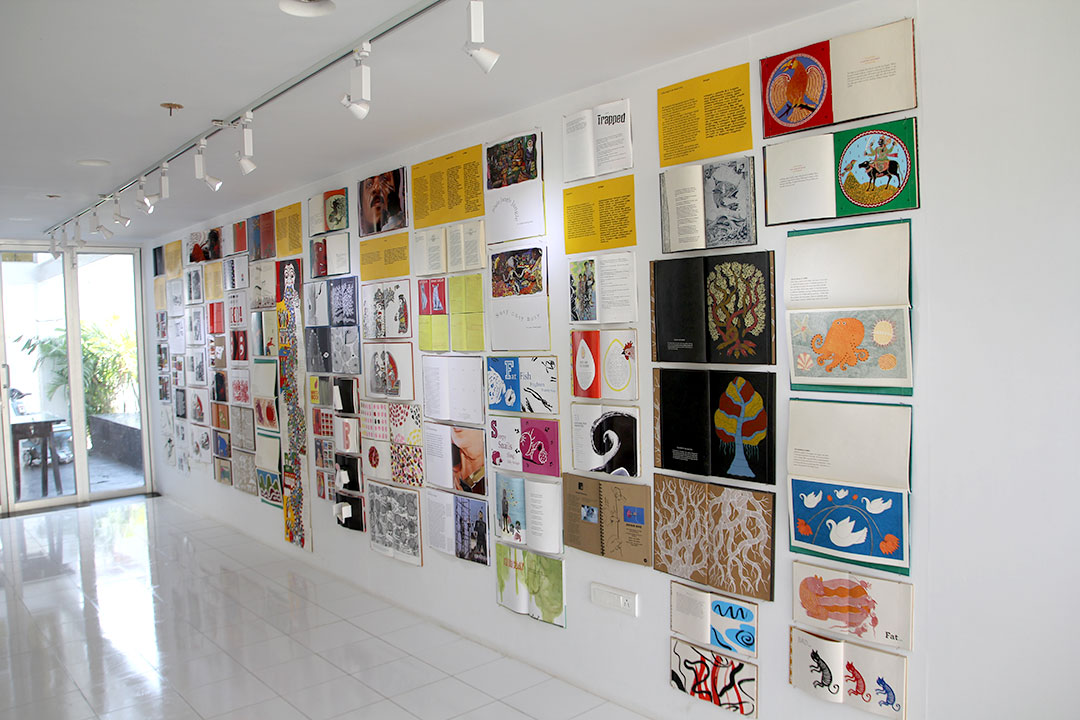
Tara at Book Building: Panel from the exhibition
Curating a Vision
In 2007, we were invited by St. Bride Library, which houses a vast archive of printing and publishing, and Central Saint Martins, University of the Arts, London to present our work, with a special focus on the book made entirely by hand. This was our first major exhibition.
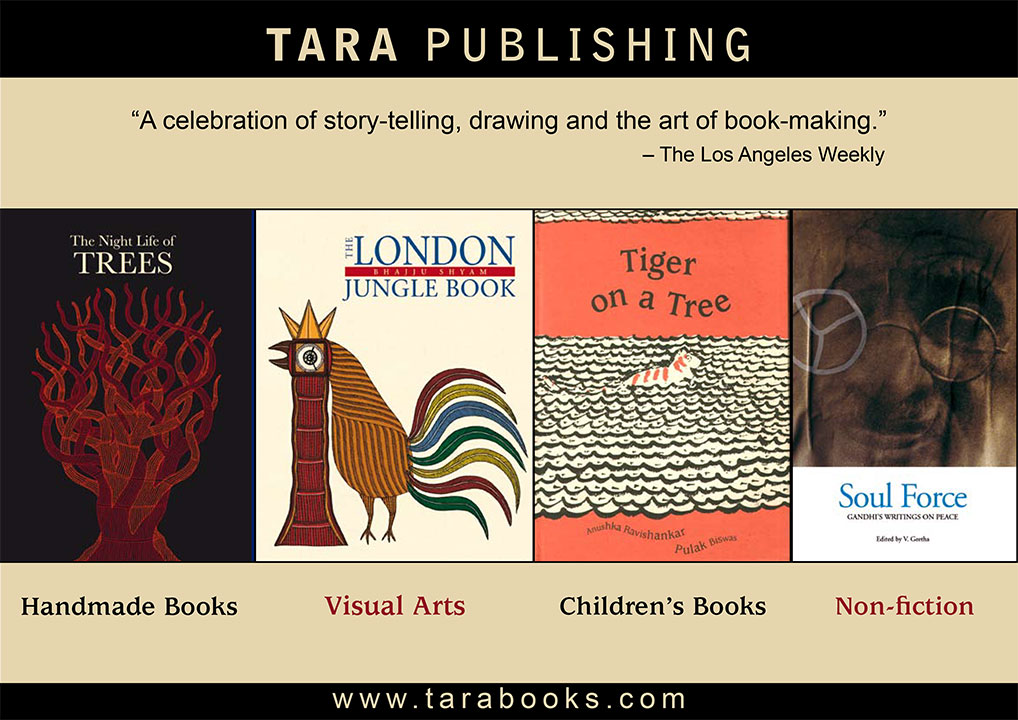
Invitation for the exhibition
Our designer Rathna Ramanathan worked closely with the Tara editorial team on this project. She insisted that the exhibition feature not only the entire range of our work at that time, but also the various steps involved in each aspect of book-making. From objects, words, and impressions that had inspired the idea or the theme for a book to the actual printed book, the exhibition would trace our work process, such as it was. For us, the challenge was this: how might we self-consciously account for what were sometimes intuitive decisions and explain what we took for granted? We met this challenge through a process of dialogue, reflection and doing and in the event combined the different stands of our work: our interest in the children’s picture book, our commitment to the pleasures of reading, delight in street art, engagement with traditions of storytelling and classical literature, our work with indigenous artists and our book-making practices. Tara’s faith in the endless possibilities of visual communication became the binding thread that held a disparate set of exhibits together: books, original art from select titles, including printed textiles and scrolls, pages from the designer’s notebook, artefacts and ephemera that inspired our work, and a range of printables, from catalogues to invitations to back stories to do with books.
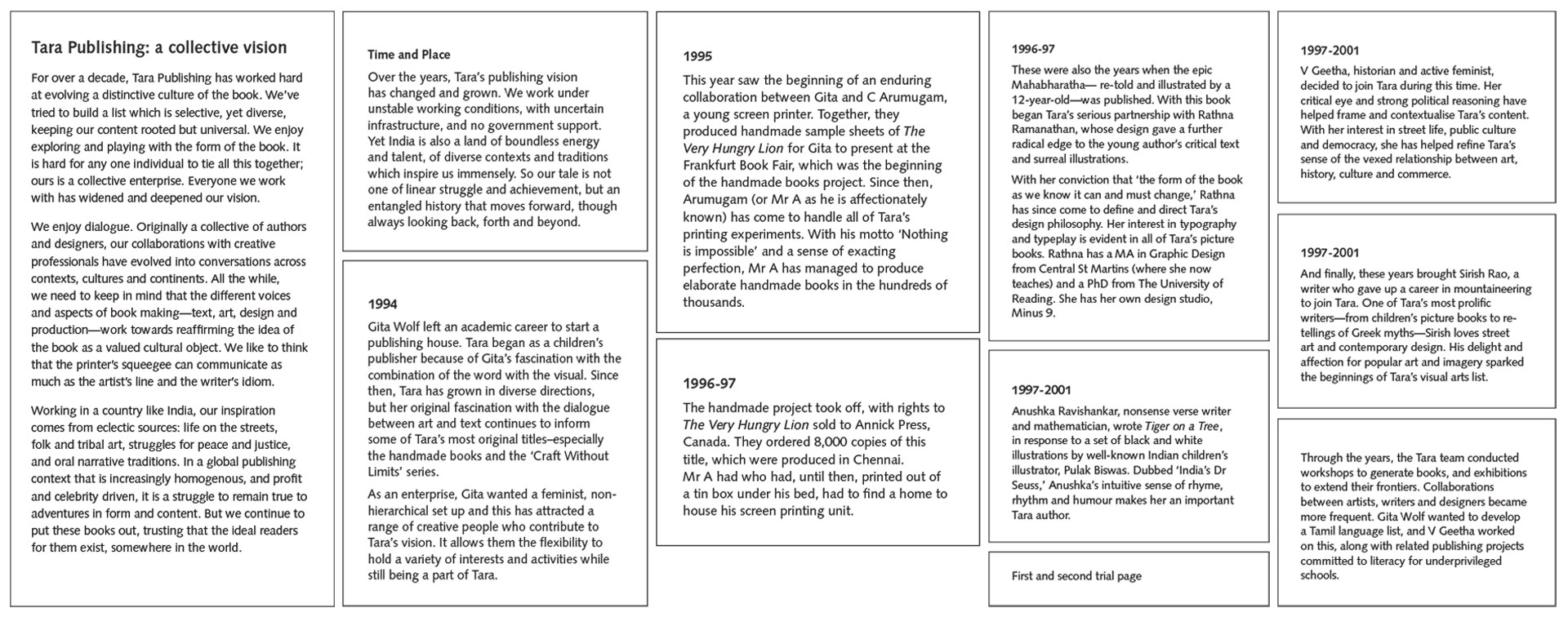
Setting the context
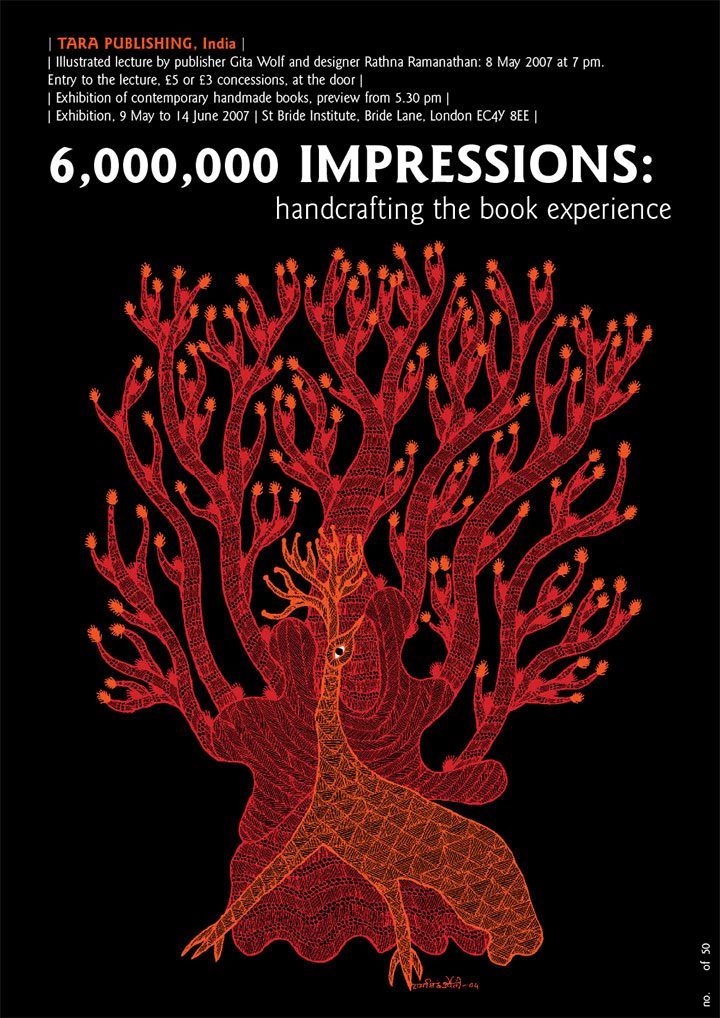
A poster about the exhibition
Titled 6,000,000 Impressions: Handcrafting the Book Experience, the exhibition unsettled standard notions of publishing and refigured it as an activity that involves artisanal making as much as it does conceptual clarity and thought. It rendered the book as a valuable cultural object which has endured over centuries, but which, as Rathna put it, is one that ought to and must subject itself to change.
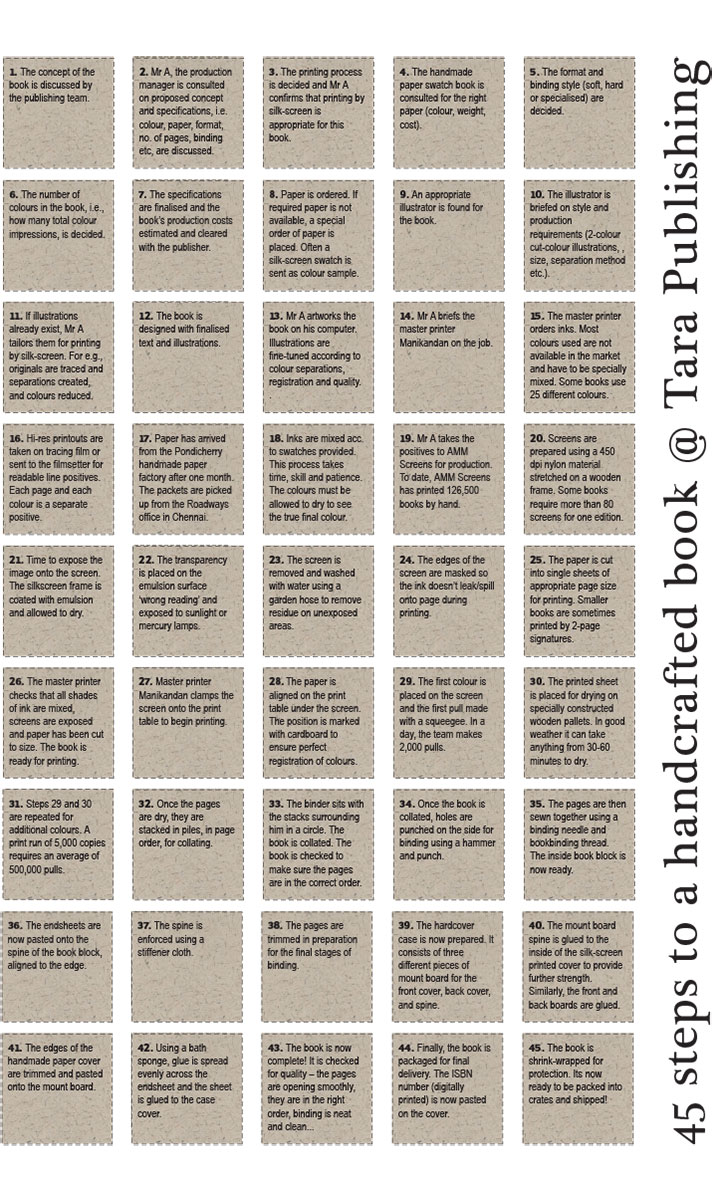
45 steps to screen-printing a book
Over the years, we went on to curate exhibitions which drew from this wide-themed first effort. Each of these was adapted to suit site-specific needs and interests, in India and elsewhere in the world. We displayed in a range of spaces as well, from bookstores to university halls to museums. Some exhibitions were simple, comprising art prints, featuring images from our books. Others were more elaborate, combining as they did, prints with photographs of our book making workshop, and video installations. We also worked at addressing in detail one or more of the themes that we had explored in 60,000 Impressions. Whatever the size or the idea that animated an exhibition, we did not fail to foreground the interconnected and layered work process that remains the hallmark of our publishing.
Ten years after we had curated our first major exhibition, we were invited to do something similar. In 2017, the Itabashi Museum, located in Itabashi Prefecture, a suburb of Tokyo, approached us with a request: they wished to host a comprehensive exhibition that took measure of our publishing, as a whole. Their idea, they said, was to demonstrate how ‘beautiful books can indeed change the world’.
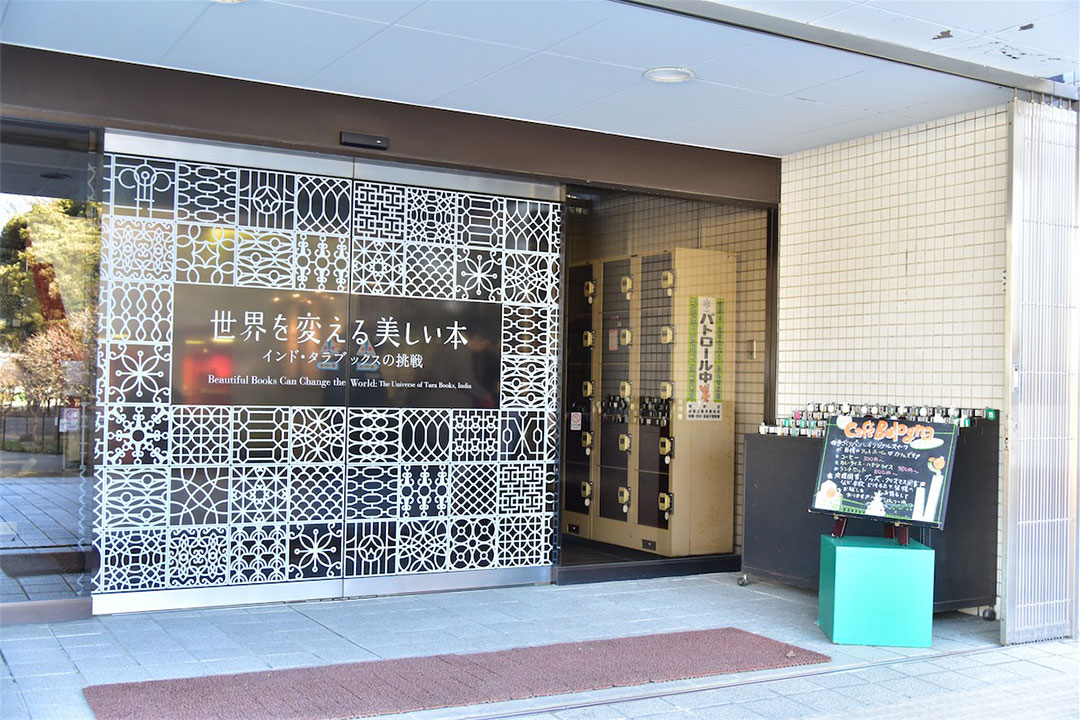
Tara Books at Itabashi Museum
The Itabashi Museum works closely with the Bologna Children’s Book Fair, and has hosted exhibitions to do with the broad theme of children’s literature. We were happy to be part of this global conversation on books and art, which encompassed not only children’s books, but also what might be called books for all ages. Besides, we were familiar with the museum. The chief curator Kiyoko Matsuoka had invited publisher Gita Wolf to do a week-long workshop on the form of the book, as part of the design and art education program that the museum undertakes every year in the summer. This had led to a long and fruitful collaboration with artists and designers from Japan, which resulted in a range of fascinating titles that we subsequently published. The museum was clearly happy with this outcome and wished to collaborate with us further.
A team of museum officials, led by Kiyoko Matsuoka visited Tara Books to discuss various aspects of curating what promised to be an expansive exhibition that yet would be attentive to detail. We decided that the exhibition would comprise two parts: the first would focus on Tara’s history and collective vision, our engagement with what we considered the global culture of the picture book, and our work with indigenous artists. The second part would feature our book-making processes, and the ways in which we worked with design, form and printing. We also suggested that we build our exhibits around a set of what we termed ‘milestone’ books — Tara titles that had broken new ground, whether in terms of textual and visual content, printing, the form of the book…
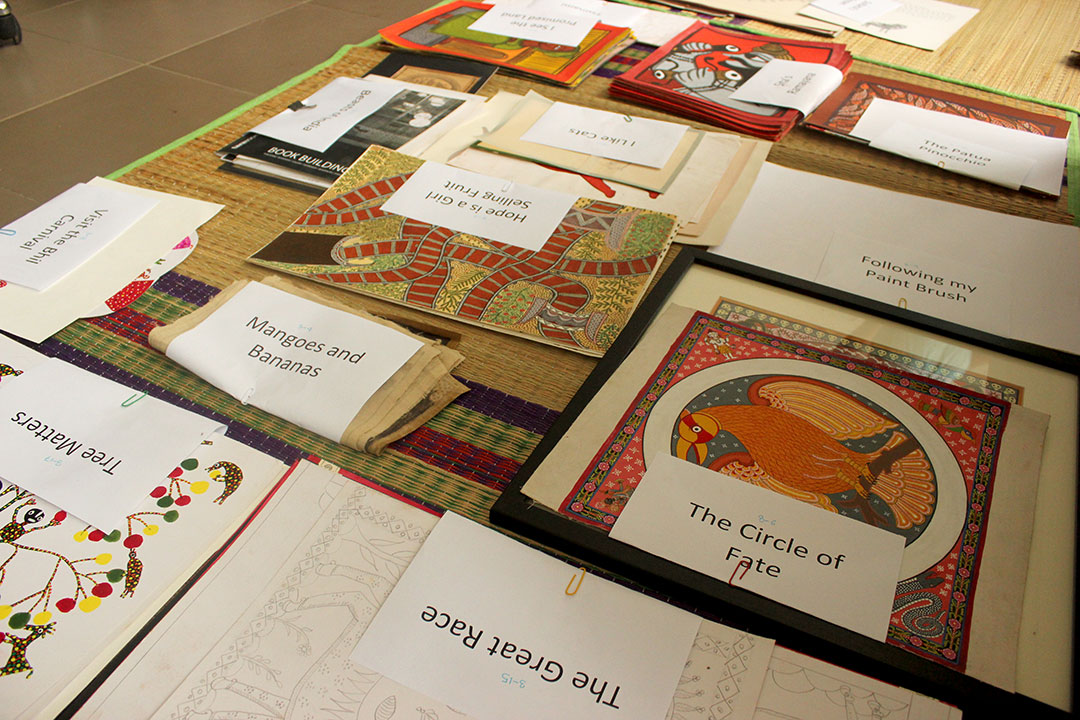
Some milestone titles
Reviewing our plan in the context of what was actually possible within the spatial limits of the museum, the Itabashi team reframed our ideas and re-grouped the exhibits, but within the overall scheme that we had envisaged. Once we agreed on the details of curation, the team made a second visit to finalise the set exhibits that would be on display.
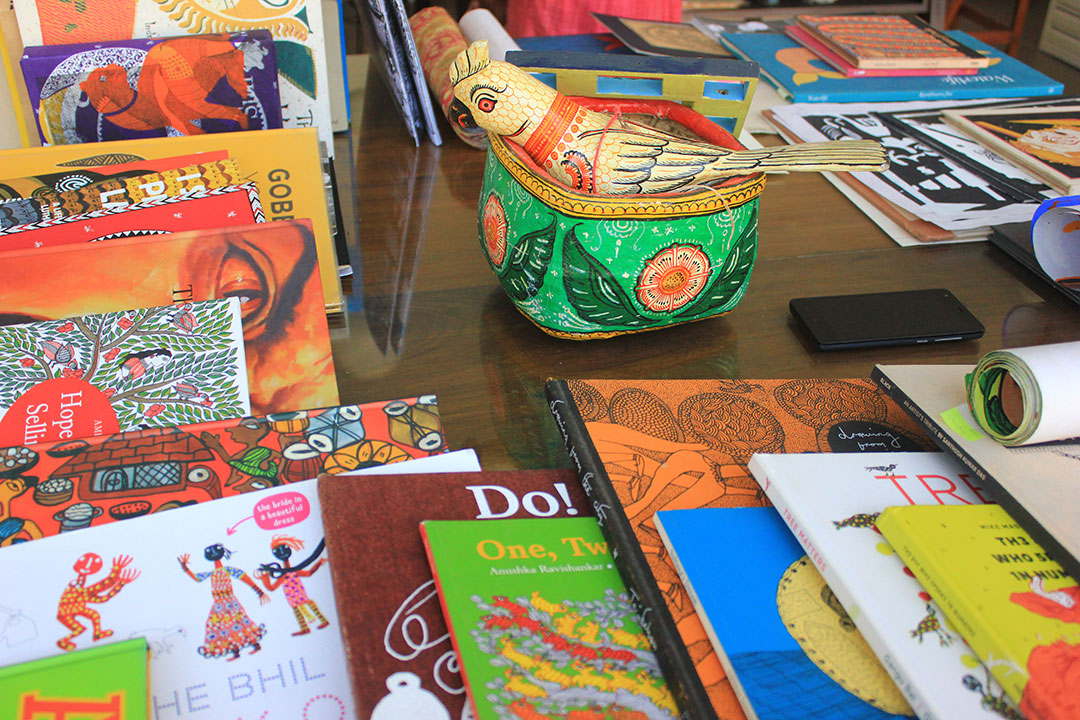
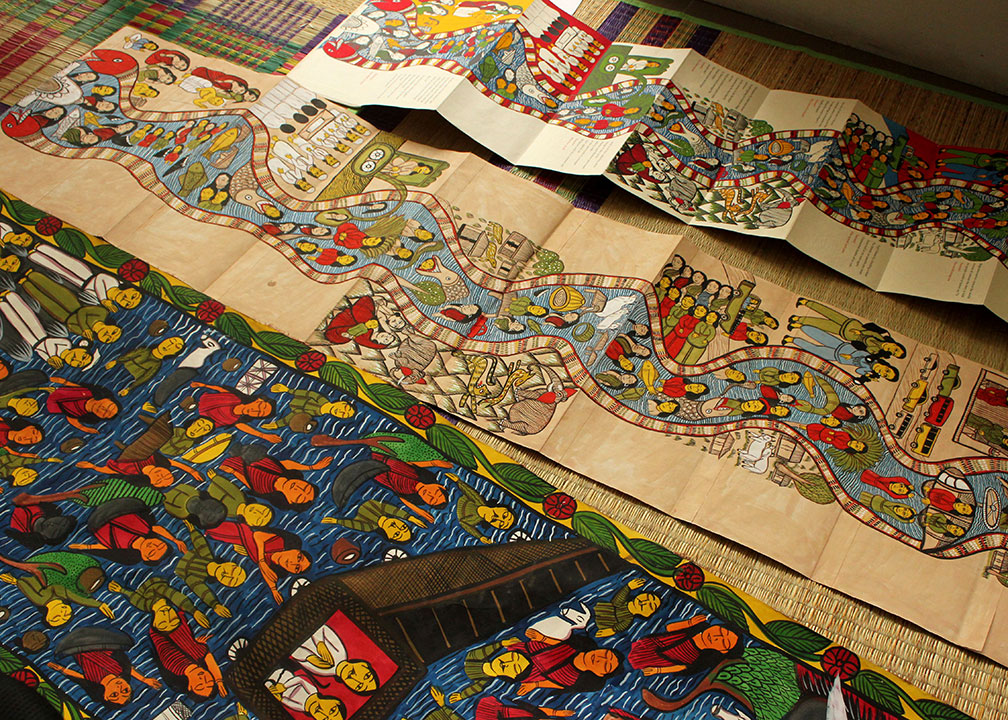
On review: Prospective exhibits
The exhibition opened in November 2017, and drew a very large number of visitors for the time that it was on. Subsequently, it was taken to four other venues in Japan.
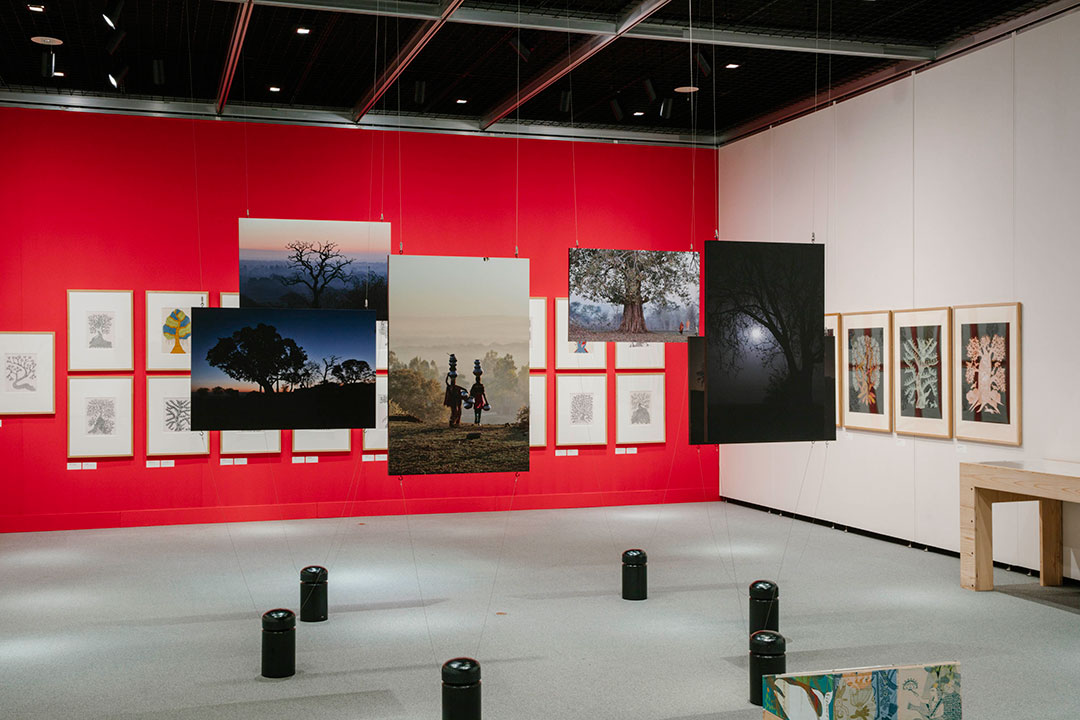
Premier exhibit: The Night Life of Trees
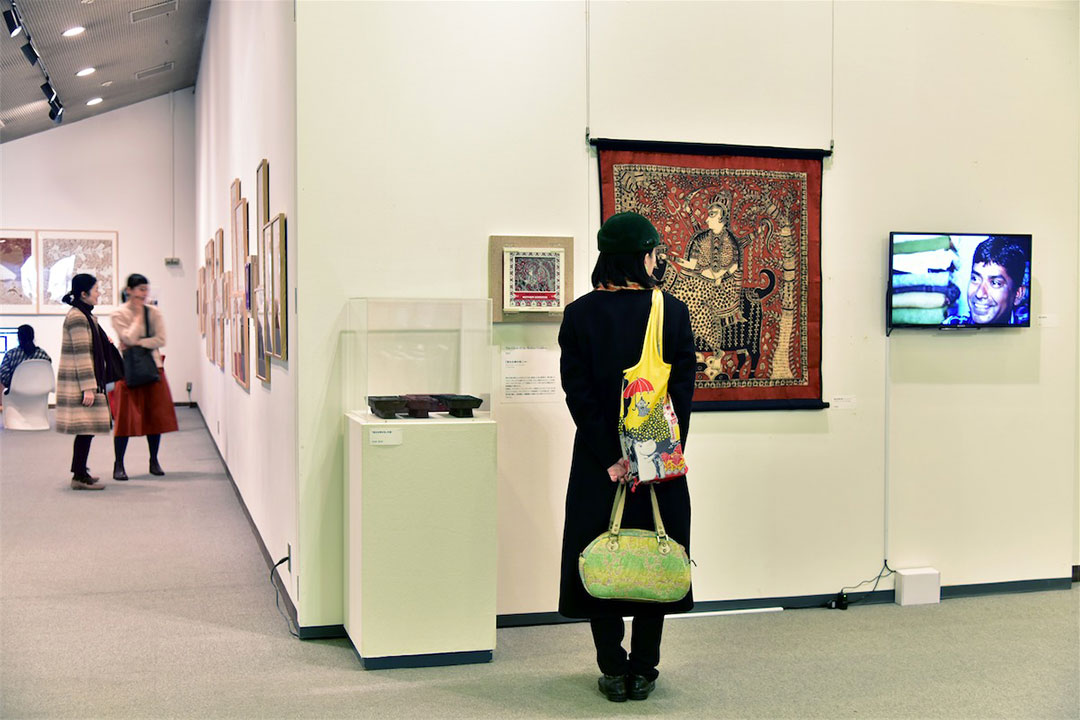
A way of seeing
A year later, it travelled to Korea as well — and was hosted in the MOKA (the Hyundai Museum of Kids’ Books & Art) in Seoul.
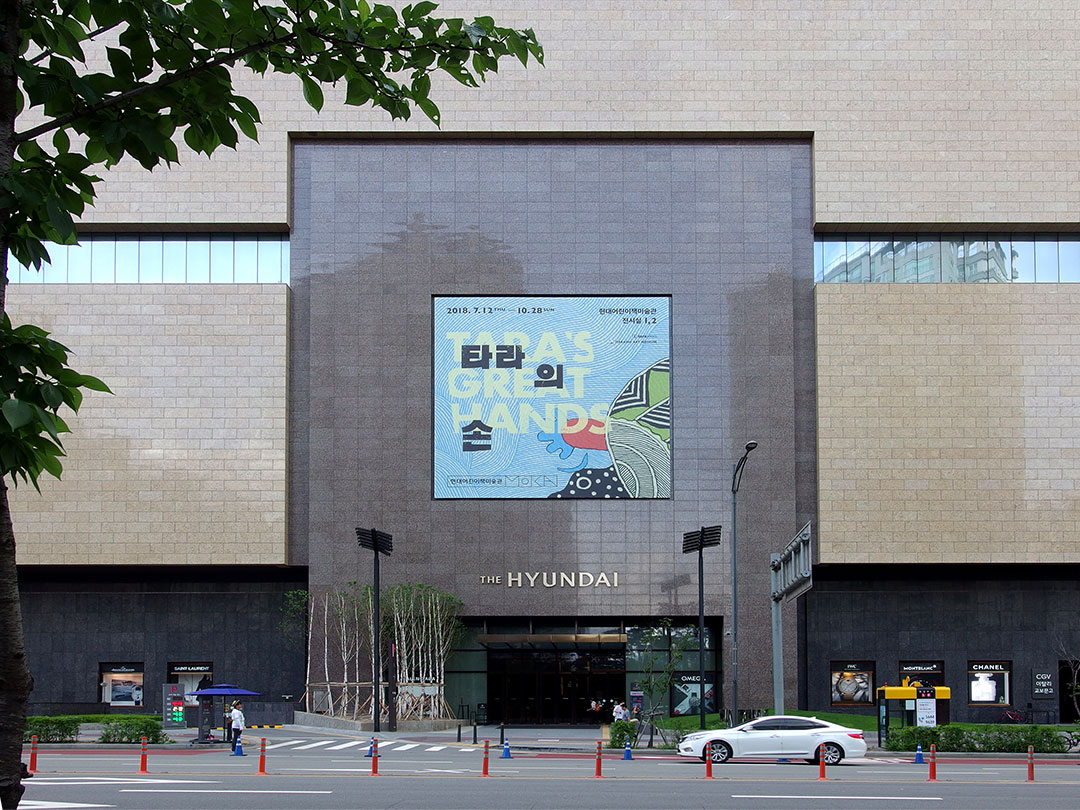
Welcome to the exhibition at the MOKA, Seoul
These exhibitions were accompanied by workshops and interactions with local publishers and the reading public and focused on the theme of sustainable independent publishing. We were called upon to speak not only of the art and craft of book-making, but also about the manner of our working — of the feminism that informed our approach to cooperative dialogue, our decision to not ‘upscale’ our work, but stay within the limits we had set ourselves, and our approach to ethical marketing and selling.
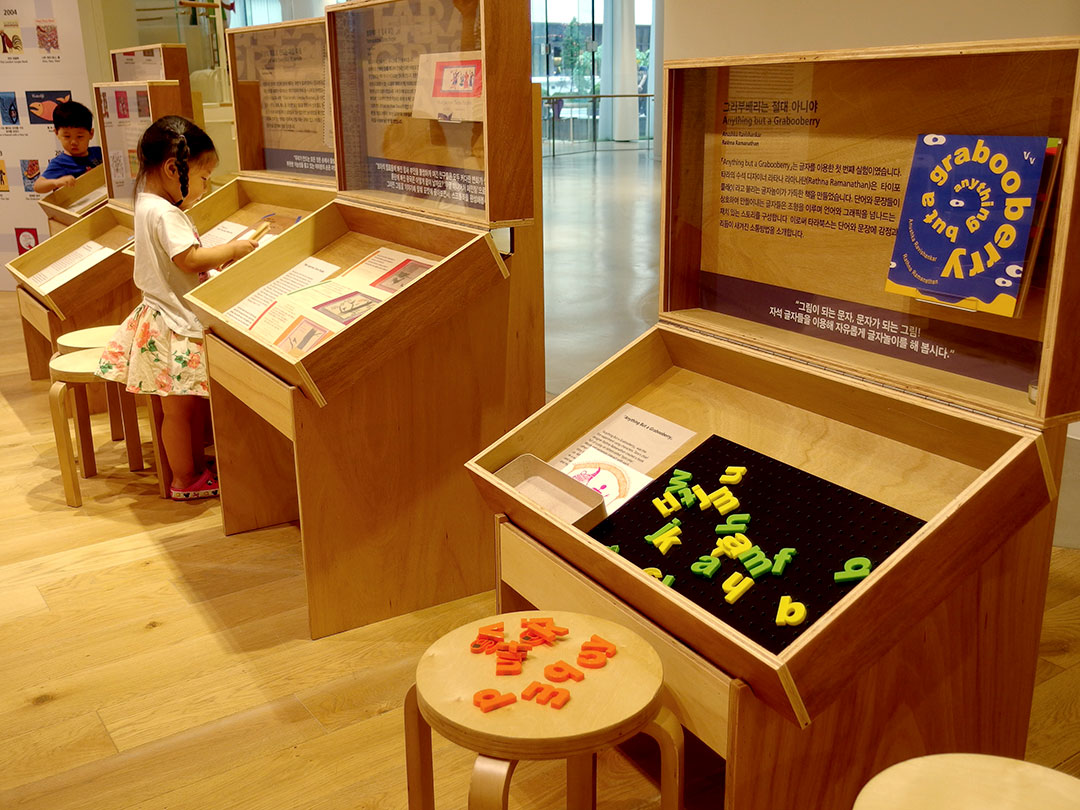
Serious viewing at the MOKA
Curation as Exploration
At Tara we have been excited and intrigued by the range and diversity of indigenous art traditions and by the worldviews that artists express in and through their art. Our books feature this art as illustration, self-expression, and argument, and in all instances, we have sought to expand our ways of seeing and understanding.
One of the things that has engaged our attention in this context is the woman artist – and her role in various traditions of art. In some communities only men paint, while in others, both men and women do. What might have only been a male-only or female-only tradition now accommodates both male and female artists. Yet, there appears to be a special meaning assigned in some traditions to what women do. Their art is seen as both labour, something they have to do, as part of their daily work, as well as signifying something more, such as rendering the home welcome, or marking the seasons. Pardhan Gond artist Bhajju Shyam, author of The London Jungle Book once remarked that it would seem that ‘women’s everyday art is the alphabet of all art’.
Wanting to explore this idea we convened a workshop on the subject and invited women artists from several traditions to draw and reflect on the drawings that they make on floor and wall, everyday, seasonally and on special occasions.
Reflecting on the workshop and all that we had heard, we decided to curate an exhibition that plotted the journey of specific traditions from floor and wall to paper and canvas and from thereon to the pages of the book. Titled From Floor to the Book, the exhibition opened at Book Building on the occasion of the International Working Women’s Day (March 8) in 2014. It featured different kinds of women’s everyday art, the materials used, the labour of creation, the ways in which this art had moved from floor and wall to paper and canvas, and finally into the book form.
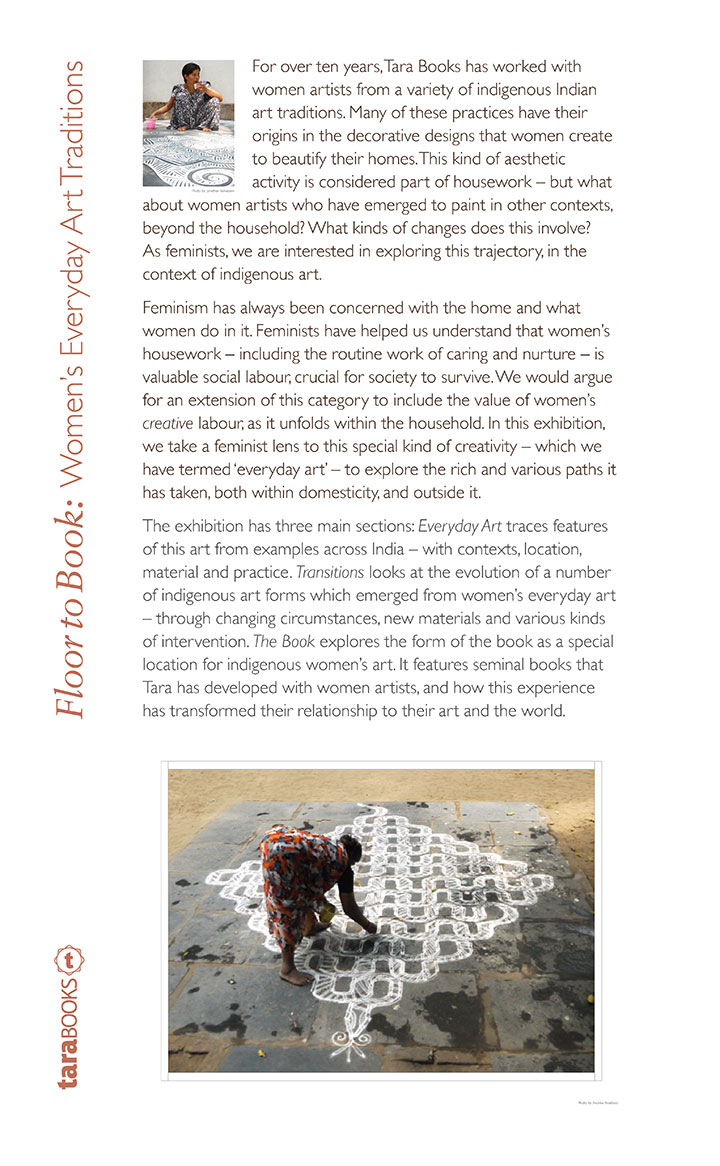
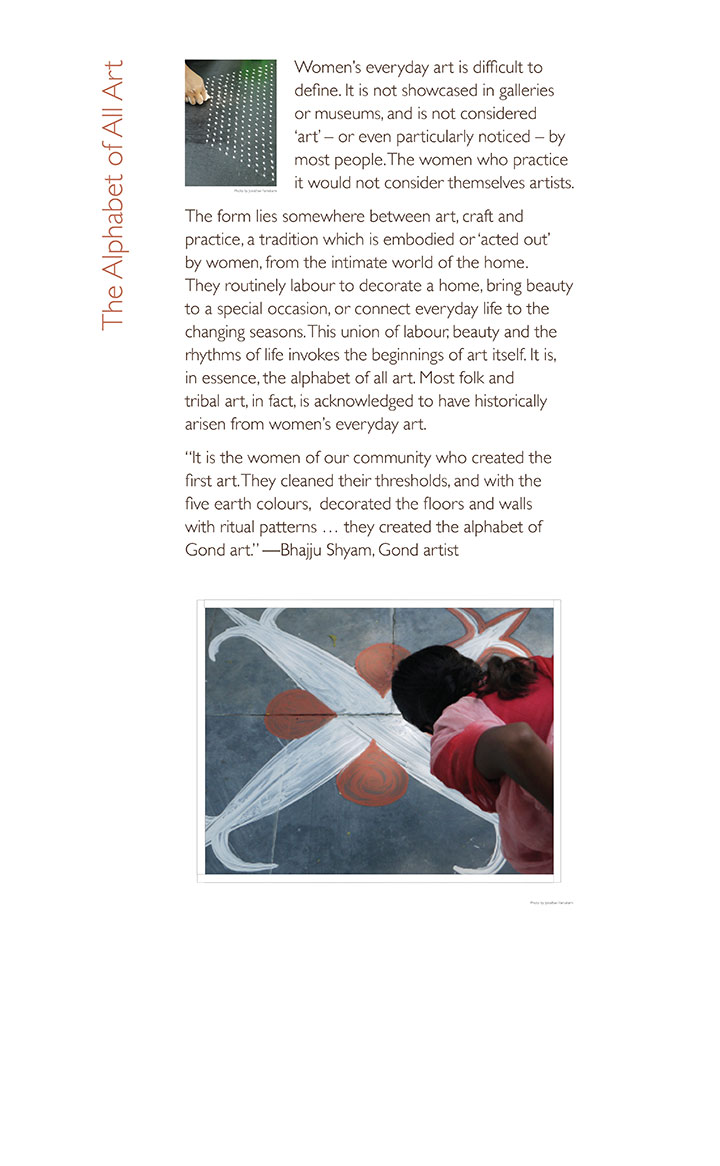
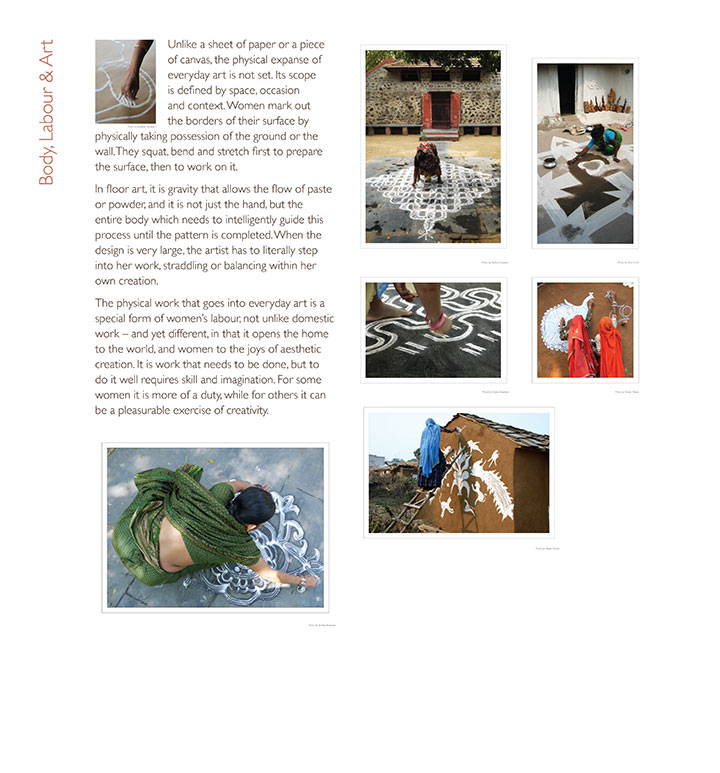
Panels from the exhibit
Specifically, the exhibition called attention to how women drew – how they took measure of space and proportion in an unselfconscious manner, yet with consummate expertise. The exhibition also pointed to how women artists have created within and beyond the confines of tradition — especially while drawing for the book.
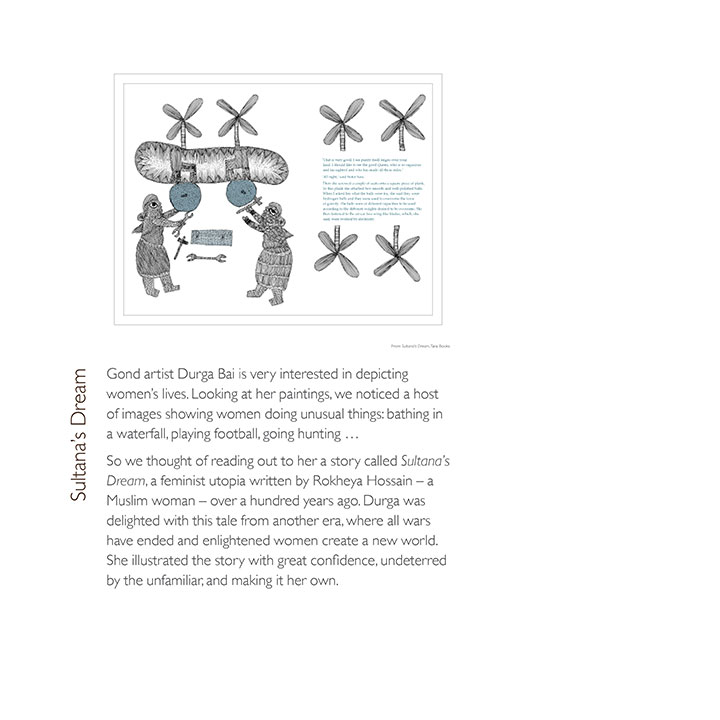
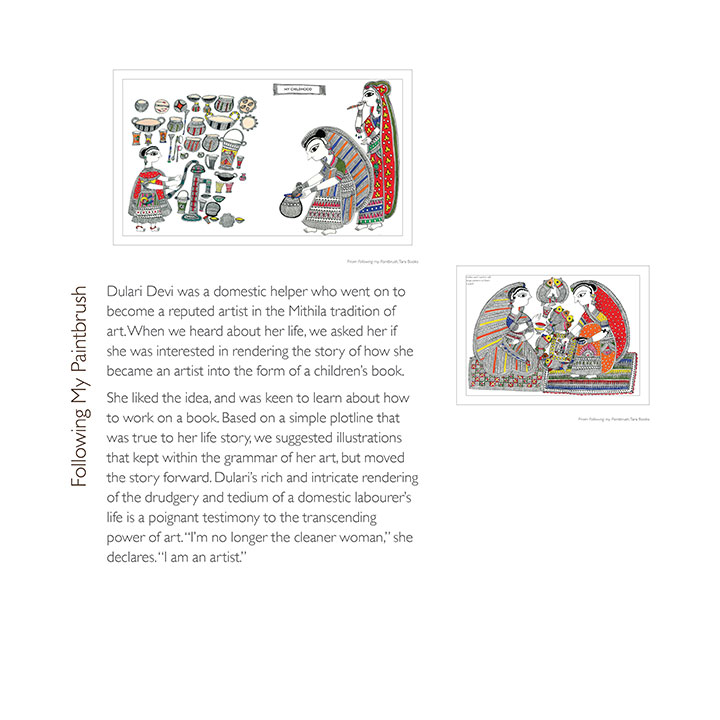
Books featured in the exhibit
Curation as Pedagogy
Tara Books has evolved a distinctive grammar of the children’s picture book, in and through a radical use of book design and the printing process. This has happened in conversation with different traditions of the picture book and with like-minded publishers we meet at various international book fairs. One such meeting resulted in a rather unusual exhibition — featuring art in children’s books from Soviet Lithuania. Originally hosted at the Bologna Children’s Book Fair, the exhibition was offered to us by the Lithuanian Cultural Institute.
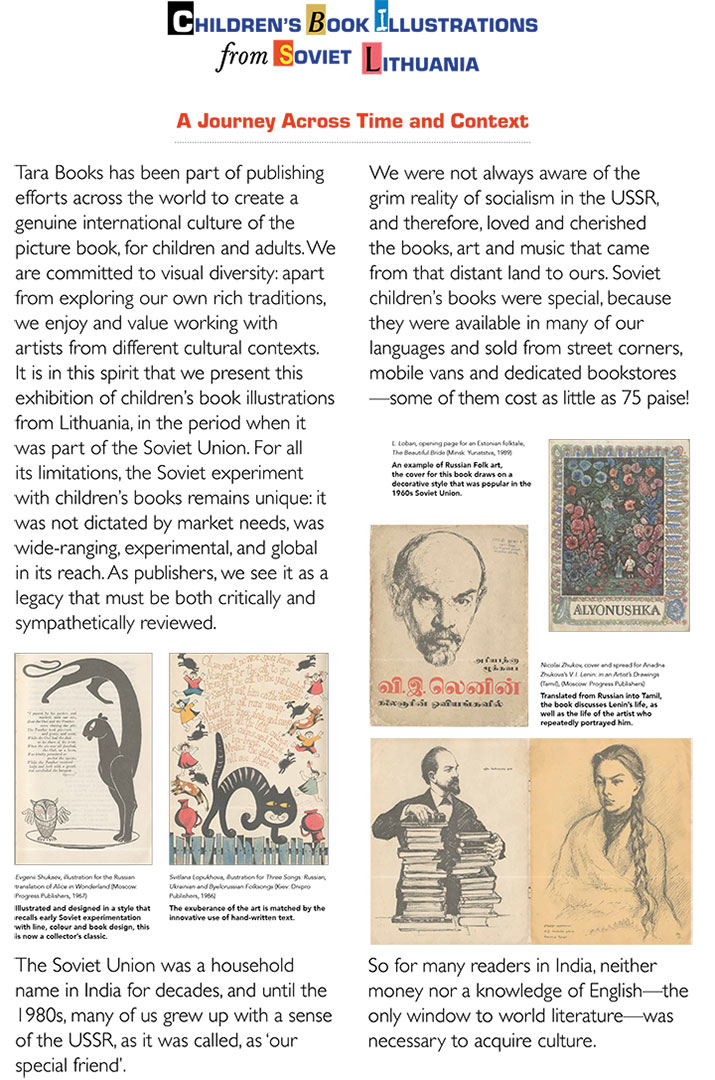
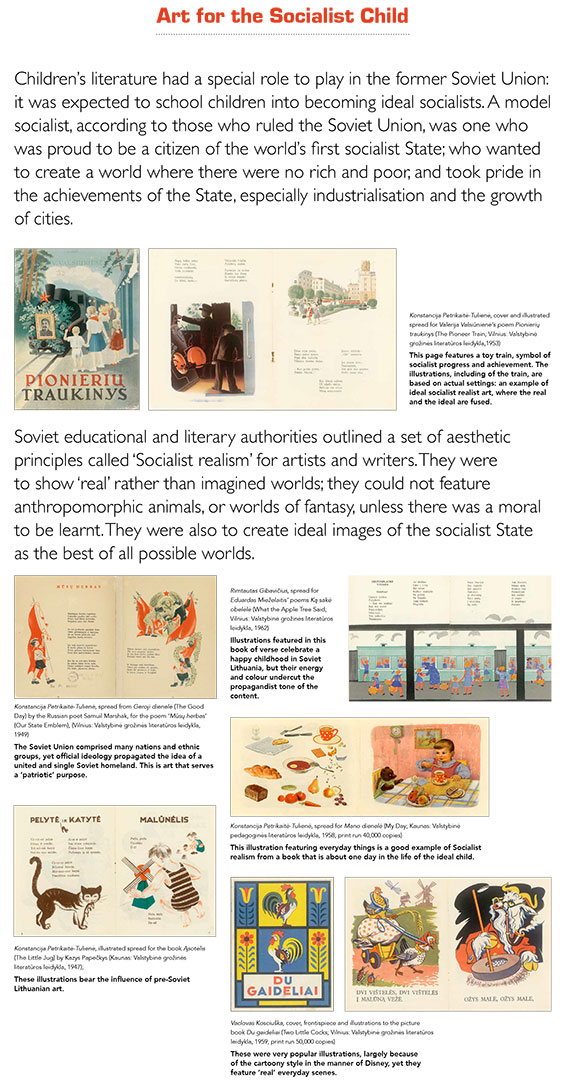
Panels from the exhibit
We thought that readers in India would relate to it, but wanted it adapted to our context. Many of us had grown up with children’s books from the Soviet Union. These books had been published in various Indian languages and were modestly priced and widely distributed. We thought that the Indian experience of these books ought to feature in the exhibition as well. For one, it would provide an interesting counterpoint to the fraught, yet, dynamic relationship that Lithuanian authors, artists, designers and readers had with the Soviet state which presided over, directed and regulated all publishing efforts. Secondly, it would point to the global reach of the Soviet book, and the reading and publishing cultures that it shaped.
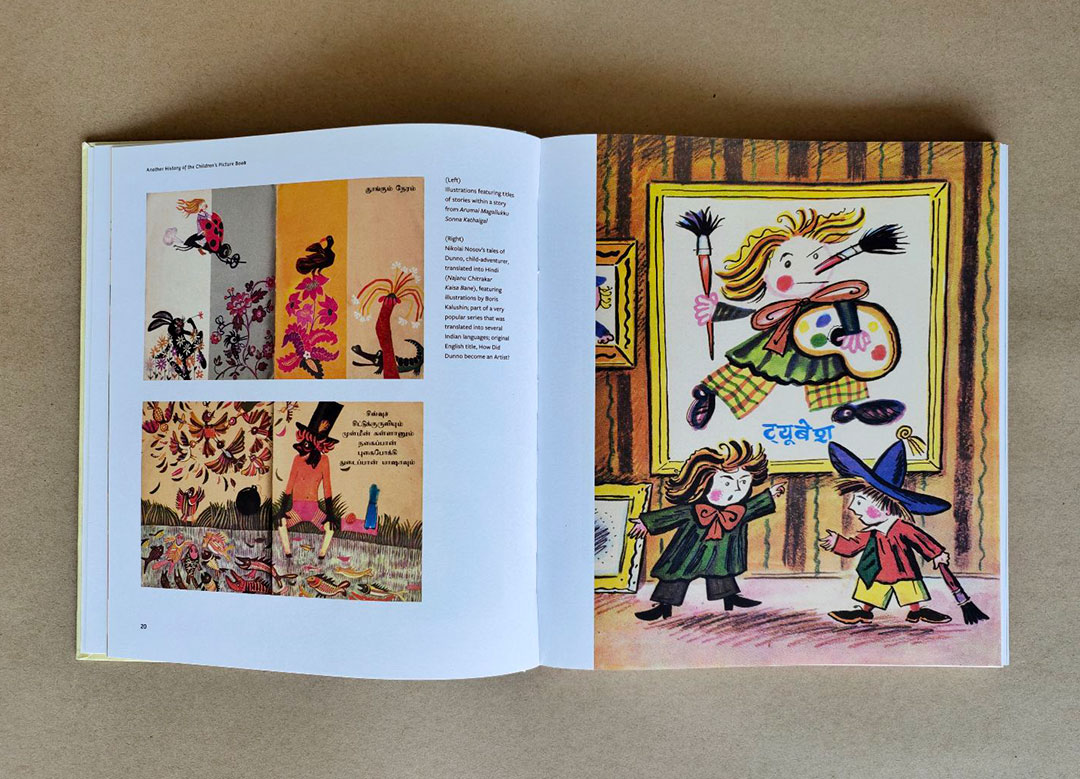
Soviet books in Tamil and English
The Lithuanian Cultural Institute was open to the idea and the result was a rather unusual exhibition, which was as much pedagogic as it was a display of rare art and text. For it brought to the attention of the viewing public a little known history of international book publishing and distribution. Drawing from the exhibition, and in conversation with its chief curator, Giedrė Jankevičiūtė, we came up with an idea for a book — which would explore ‘another history of the children’s picture book’, and pointed to the role of the Soviet Union in this context.
Curation as Play
Whimsy, humour and play are present in many of Tara’s titles, for children and for adults. When we turned 25, and wanted to mark the moment, Rathna Ramanathan, who had set the terms for children’s book design at Tara, came up with a quizzical idea for an exhibition: she wanted all that worked at Tara, in editorial, design and at the book-making workshop to list their favourite Tara title and choose their favourite lines from it. Based on these choices, she wanted to create a set of 25 plus posters, through calligrams and type play.
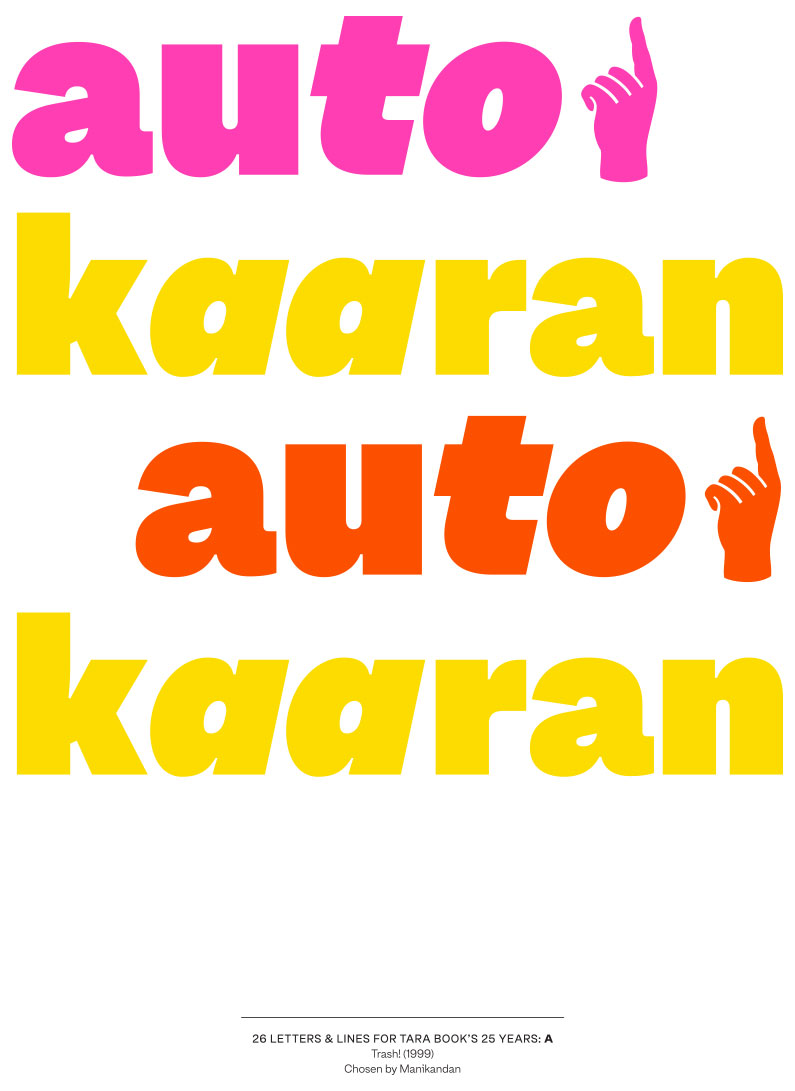
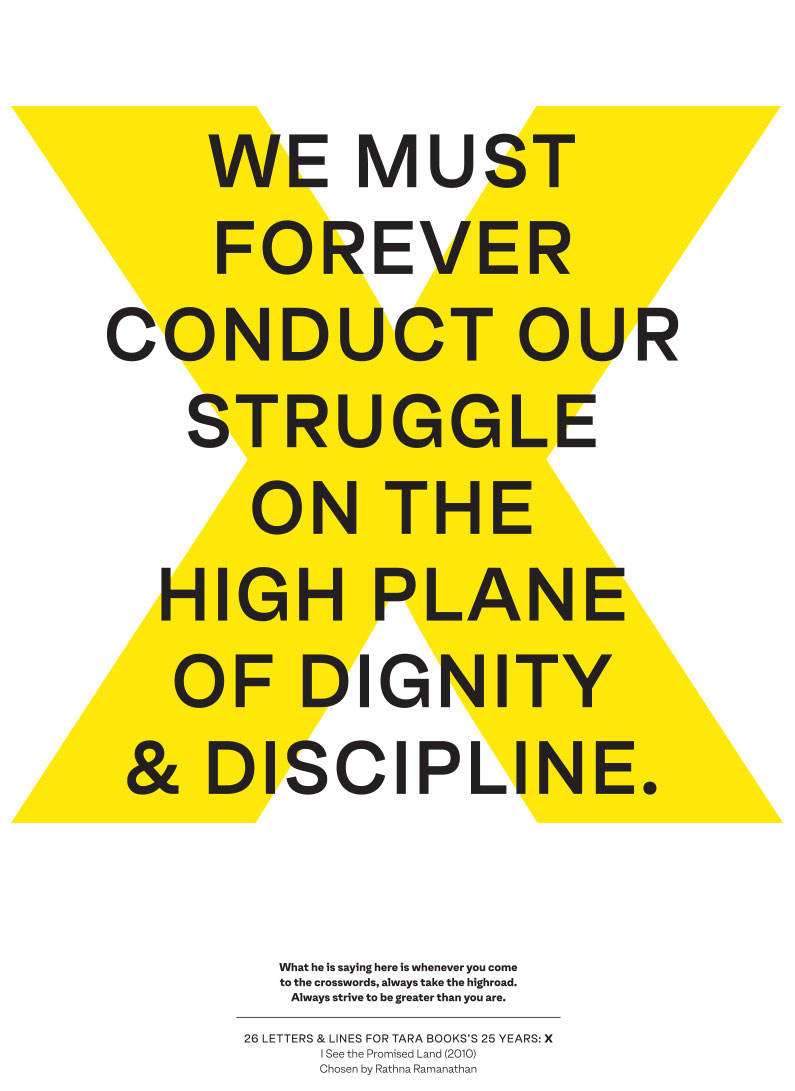
Two posters from the exhibit
While Tara is known mostly for the art it publishes, and the book craft it promotes, it has been equally committed to an exploration of language and contemporary design — through an inventive use of type, and by bringing the word and image into interesting conversations, Tara’s designers had rendered the book as a space where one ‘pictures’ words and ‘reads’ pictures. Rathna wished to commemorate the many ways in which language works in Tara’s books — and call attention to how type embodies voice, accent, tone, rhythm and pitch. The result was a set of stunning posters that were funny, irreverent, grave and playful, and which together pointed to the diffuse and rich creative force that has sustained our publishing.
While reading is essentially a solitary activity, the book is a social object, and our exhibitions link it to diverse contexts and worlds of creation, production and dissemination. Curation has thus helped map the many journeys that make a book possible: the inspirations that birth it, the processes that shape its form and content and the different ways in which it ventures forth into the world. Equally, curation has demonstrated how a book might be viewed, as a hub for conversations about making and reading and imagining.
Interested in more details about our exhibitions? We’re happy to discuss bespoke exhibitions — contact moc.skoobarat@ilapeed
V. Geetha is a historian and translator and has been active in the women’s movement for over 3 decades. She has a special interest in pedagogy. Her work at Tara Books includes editing, writing, and working across different aspects of publishing to ensure that Tara’s publishing philosophy remains in focus, in all that they do.
Click here to discover Tara Books she has authored.



No Comments